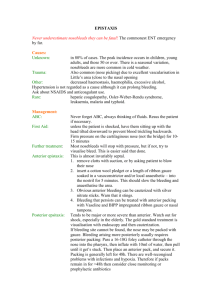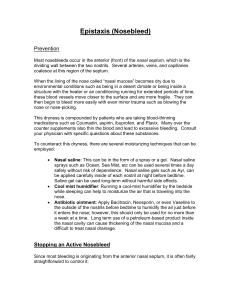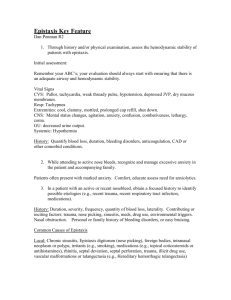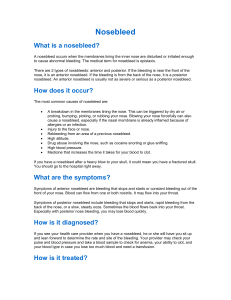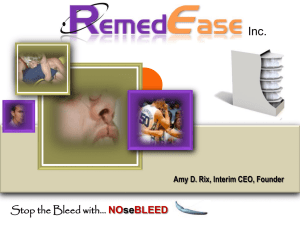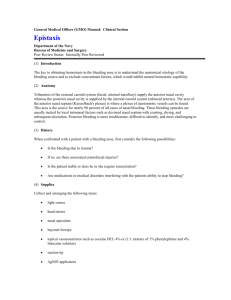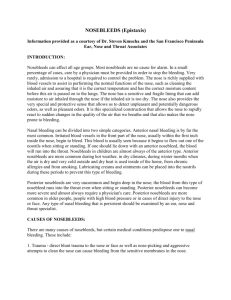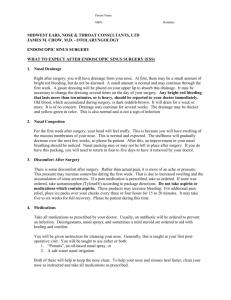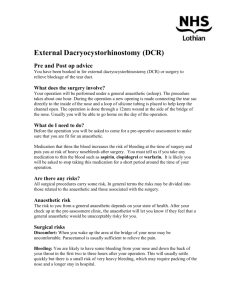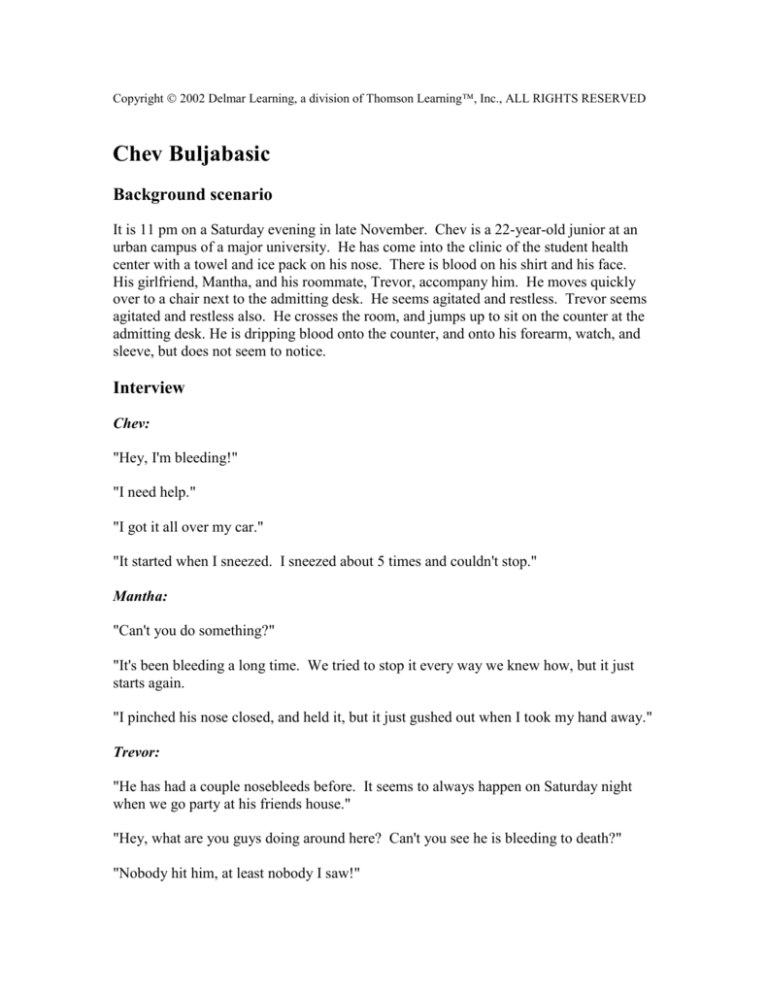
Copyright 2002 Delmar Learning, a division of Thomson Learning, Inc., ALL RIGHTS RESERVED
Chev Buljabasic
Background scenario
It is 11 pm on a Saturday evening in late November. Chev is a 22-year-old junior at an
urban campus of a major university. He has come into the clinic of the student health
center with a towel and ice pack on his nose. There is blood on his shirt and his face.
His girlfriend, Mantha, and his roommate, Trevor, accompany him. He moves quickly
over to a chair next to the admitting desk. He seems agitated and restless. Trevor seems
agitated and restless also. He crosses the room, and jumps up to sit on the counter at the
admitting desk. He is dripping blood onto the counter, and onto his forearm, watch, and
sleeve, but does not seem to notice.
Interview
Chev:
"Hey, I'm bleeding!"
"I need help."
"I got it all over my car."
"It started when I sneezed. I sneezed about 5 times and couldn't stop."
Mantha:
"Can't you do something?"
"It's been bleeding a long time. We tried to stop it every way we knew how, but it just
starts again.
"I pinched his nose closed, and held it, but it just gushed out when I took my hand away."
Trevor:
"He has had a couple nosebleeds before. It seems to always happen on Saturday night
when we go party at his friends house."
"Hey, what are you guys doing around here? Can't you see he is bleeding to death?"
"Nobody hit him, at least nobody I saw!"
Examination
Vital signs:
Temperature: 99.4°F
Pulse: 120
Respiration rate: 28
Blood pressure: 118/80
Observation:
Skin is pale.
Client swallows frequently.
Voice sounds "nasally", and wet.
Blood is noted on shirt and towel. When client removes towel from nose, blood runs out.
Client appears anxious and agitated. His arm and leg movements are sudden and jerky.
His attention seems easily distracted, and his gaze wanders around the room. He makes
verbal comments about people and objects in the room, but does not appear to be able to
prioritize his thoughts or actions in a matter that supports concern over his physical
complaint.
Pupils are dilated.
There is no sign of external trauma to the face.
Palpation:
Normal
Auscultation:
Respirations are shallow and rapid.
Lungs are clear.
Hyperactive bowel tones are present in all four quadrants of abdomen.
Laboratory reports:
Hematocrit: 44% (Normal male: 41 to 53%)
Hemoglobin:15.3 g/dL (Normal male: 13.5 to 17.5 g/dL)
Prothrombin time, partial thromboplastin time. Platelet count is normal.
As time passes
Chev admits to snorting cocaine at a party prior to his nosebleed. He admits to regular
cocaine use. The physician prepares to pack the nose.
Background education
Nosebleeds, known as epistaxis, occur when one or more of the blood vessels in the nose
are ruptured, most often due to injury to the nasal membranes covering the blood vessel.
Nosebleeds can be caused by several factors. Primary are factors that dry out or irritate
the nasal membranes. These include dry air, viruses, allergies, colds, antihistamines,
decongestants, or picking at crusts and itchy spots inside the nose. A second cause of
nosebleeds is related to factors external to the nose, primarily an injury or a blow to the
outside of the nose, or a foreign body inside the nose, which causes injury to the nasal
mucosa.
Finally, some medical conditions can cause frequent nosebleeds, including polyps, blood
disorders, coagulation disorders, surgery to the nose area, anticoagulant medications,
cancer, immune disorders, or hypertension.
The nose is divided by the nasal septum into two sides. Each side has an anterior area,
the anterior nasal septum, and a posterior area. The nasal cavities are supplied with blood
from the internal and external carotid arteries. Kiesselbach’s plexus is a very vascular
area on the top of the anterior nasal septum is the most common origin of a nosebleed.
The mucosa covering this area is very fragile and the area lies tight against underlying
cartilage, offering little buffer for trauma.
Most nosebleeds stop by themselves. The first priority in nursing assessment is to check
and maintain an adequate airway, for oxygenation, and to prevent aspiration. Then,
assessment and intervention to stop the bleed is begun. For nosebleeds that continue
beyond three to four minutes, the first approach is to apply simple pressure externally to
the nose to stop the bleeding. Calm the client and have them sit quietly, leaning forward.
Flex the neck anteriorly, until the chin touches the chest. With thumb and forefinger,
have the client pinch the anterior septal area tightly, and press the pinch back toward the
bones of the face. The client must hold this pressure for at least five minutes. Repeat at
necessarily if bleeding resumes. If the pinch is released prior to the five-minute mark,
start over. This maneuver will often stop bleeding which originates in the Kisselback’s
plexus area. If the bleeding is posterior to the site of the pressure, this will not stop the
bleeding, but blood will spill over into the nasopharynx and can be spit out. Extending
the head backward, a traditional response to nosebleeds, actually increases the risk of
aspirating or swallowing blood, and should not be done. Laying flat or putting the head
lower than the heart is not helpful and may worsen the bleeding. Ice packs to the nose,
face, or back of neck are often used with mixed results.
Bleeding which does not stop with these measures needs additional treatment by a
physician. This includes diagnosing the exact location of the bleed, using an endoscope
or a speculum. The mucosa is anesthetized and interventions to stop the bleeding are
undertaken. Interventions can include packing the nose, using commercial nasal packs,
or petroleum gauze. Both anterior and posterior nasal packing can be done. Antibiotic
ointment is often used on the packs, and/or antibiotic therapy is used when packs are used
to reduce the risk of sinus infections. Cauterizing the bleeding vessel with electrocautery
or silver nitrate can be used, followed by packing. Vasoconstrictors, including topical
oxymetazoline hydrochloride (Afrin), cocaine, or epinephrine can be used. Surgical
interventions to ligate the bleeding vessel are a last resort if other methods are ineffective,
or if the nosebleed is severe enough to be life threatening.
Nursing assessment for a nosebleed includes gathering information about the client's
history of nosebleed and looking for possible causes. Intervention includes blood
pressure, emergency interventions to locate and treat the source of the bleeding, lab work,
and radiographs as ordered by the physician. Nursing interventions for severe nosebleeds
may include assisting the physician with suction, lighting, or the packing procedure.
Chev’s blood must be treated as if it is infected. Universal precautions must be followed
at all times. Universal precautions is a protocol that assumes that all human blood and
bodily fluids are infected with blood borne pathogens that can be transmitted to the
caregiver. Barrier protection is used at all times to prevent skin and mucous membranes
of caregivers from coming in contact with contaminated materials. The extent of barrier
protection must be appropriate to the type of exposure anticipated. With Chev’s
nosebleed, contaminated blood can be dripped, splashed, or cover items or surfaces in the
environment. Precautions include blood containment, protective gloves, gown, eyewear,
and surgical masks. Hands or other skin surfaces must be washed immediately if
contaminated, or immediately after removing gloves.
Client education includes advising the client to avoid activities that might cause bleeding
to resume, including vigorous exercise, eating hot or spicy food, drinking alcohol, or
tobacco use. Picking or blowing the nose or sneezing with the mouth closed is to be
avoided. The client is advised to apply topical medications, petroleum jelly or nasal
sprays as ordered and to take oral antibiotics as prescribed. A follow-up visit to remove
the packing and assess the nasal mucosa will be scheduled.
Other interventions might include remedies to lower blood pressure, discontinuation of
anticoagulant medications, or further assessment to rule out causes of the nosebleed.
Drug use and nosebleed
Users inhale cocaine powder through the nose. The cocaine is absorbed into the mucous
membrane of the nose and into the blood stream. Cocaine is a central nervous system
stimulant. It causes increased pulse, respirations, and body temperature, dilated pupils,
increased inability to sit still, headache, dizziness, difficulty concentrating, listlessness,
and time distortion is common.
Cocaine, when snorted into the nose, is irritating to the epithelium of the nasal passages
and causes itching and crusting. It also acts as a vasoconstrictor. Repeated use causes a
cycle of ischemia, inflammation, micronecrosis, and infection leading to macronecrosis.
With extended abuse, septal perforation is common.
List your findings and conclusions:
Nosebleed due to nasal irritation from snorting cocaine
Nursing diagnoses:
00004 Risk for infection
00028 Risk for deficient fluid volume
00140 Risk for injury
00146 Anxiety
00079 Noncompliance.
00044 Impaired tissue integrity
00099 Ineffective health maintenance
00122 Disturbed sensory perception
00130 Disturbed thought processes
00069 Ineffective coping
Quiz
1. Nosebleeds occur when one or more of the blood vessels in the nose are ruptured.
This is most often due to
a.
b.
c.
d.
Drug use or medications
Injury to the nasal membranes
Hypertension
Blood disorders
2. Bleeding that does not stop with standard measures requires additional treatment by a
physician. What is a last resort when treating a nosebleed?
a.
b.
c.
d.
Surgical ligation
Calm the client.
Pack the nose.
Apply ice packs to the face or nose.
3. Extending the head backward, a traditional response to nosebleeds, actually increases
the risk of aspirating or swallowing blood, and should not be done. What intervention
may actually make the nosebleed worse?
a.
b.
c.
d.
Applying external pressure to the nose
Placing the head lower than the heart
Packing the nose
Applying ice packs
4. Mr. Buljabasic was diagnosed with nosebleed due to nasal irritation from snorting
cocaine. What is not a nursing diagnosis related to nosebleeds?
a. Risk for injury
b. Risk for deficient fluid volume
c. Impaired verbal communication
d. Anxiety
5. Client education includes advising the client to avoid activities that might cause
bleeding to resume. The nurse tells the client to avoid
a.
b.
c.
d.
Taking hypertension medication
Applying nasal sprays
Vigorous nose blowing or coughing
Bending from the waist
6. Cocaine is absorbed into the mucous membrane of the nose and into the blood stream.
It is a central nervous system stimulant. Cocaine, when snorted into the nose, can
produce all but which of the following symptoms?
a.
b.
c.
d.
Constricted blood vessels in the nose
Headaches
Dizziness
Decreased pulse and respirations
7. Client education includes advising the client of factors than can cause bleeding to
resume. What is a factor that can dry out or irritate the nasal membranes?
a.
b.
c.
d.
Picking at crusts and itchy spots inside the nose
Viruses or allergies
Colds
All of the above
8. The nose is divided by the nasal septum, into two sides. Each side has an anterior
area, the anterior nasal septum, and a posterior area. What is the source of blood supply
to the nasal cavities?
a.
b.
c.
d.
Internal and external carotid arteries
Dural sinuses
Common carotid arteries
External jugular vein
9. Some medical conditions can cause frequent nosebleeds. What disorder is among the
list that can cause frequent nosebleeds?
a.
b.
c.
d.
Tuberculosis
Cancer or immune disorders
Acrophobia
Pneumonia
10. Kiesselbach’s plexus is a very vascular area on the top of the anterior nasal septum is
the most common origin of a nosebleed. For nosebleeds that originate in the
Kisselback’s plexus area, what intervention is least likely to stop the bleeding?
a. Apply external pressure to the nose.
b. Calm the client, and have them sit quietly, leaning forward.
c. Apply ice packs to the face and nose area.
d. Pinch the anterior septal area tightly, and press the pinch back toward the bones of the
face for at least five minutes.
Copyright 2002 Delmar Learning, a division of Thomson Learning, Inc., ALL RIGHTS RESERVED

